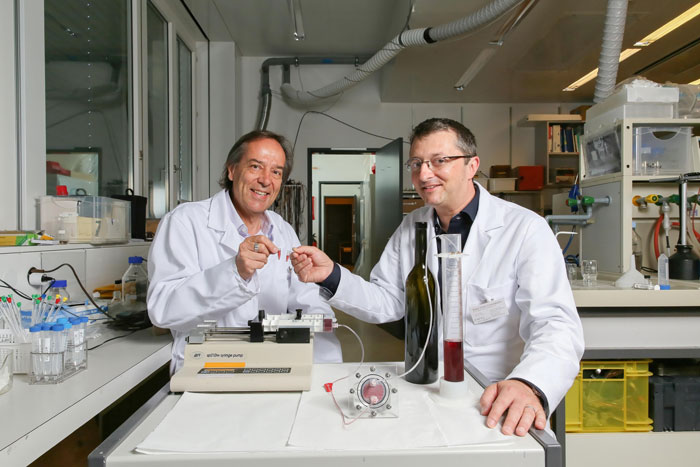Researchers have developed a miniature device capable of producing an endless supply of wine on the spot, by fermenting plain old grape juice with the help of some strategically placed yeast.
This "micro winery", currently being trialled by American and Swiss scientists, can turn grape juice into alcoholic wine in the space of just 1 hour - way faster than conventional winemaking in barrels, which can sometimes take weeks.
The micro winery was developed by researcher Daniel Attinger from Iowa State University, and despite its obvious appeal, it's more of a research tool than the next big device for your kitchen (damn). Attinger, whose research area is multiphase microfluidics, invented the system to help wine experts and winemakers improve their understanding of fermentation processes.
Wine is traditionally made by adding yeast to barrels of grape juice, but this fermentation process typically takes from one to three weeks to complete. With the micro winery, the same reaction takes place in a much more confined space, dramatically speeding up the process.
Yeast is stored in small compartments and is released into a main channel containing grape juice, through a thin membrane perforated with nanopores.
When the yeast and grape juice combine, the yeast absorbs the sugar and releases alcohol and carbon dioxide – much like in barrel wine – but the first sample is available in just 1 hour instead of taking weeks.
That rapid turnaround time could make a world of difference for commercial winemakers, who may want to experiment with new ingredients or methods without having to wait around for weeks to sample the results.
"Let's say a winemaker in the Lavaux region of Switzerland finds that a certain type of yeast or a certain fermentation temperature leads to an overly bitter wine. We could quickly test alternatives," said Attinger. "At a traditional winery, it takes weeks to separate the yeast from the wine, because they're mixed together. That's not a problem here."
Attinger is currently testing the device with scientists at the École Polytechnique Fédérale de Lausanne (EPFL) in Switzerland. The micro winery's ability to test variable ingredients and temperatures in short time frames could be particularly helpful to winemakers in light of global warming, the researchers say, because of the way hotter temperatures are affecting vineyards.
" Climate change is having an impact on the quality of grape crops around the world," said Attinger. "Due to the heat, some crops ripen too quickly, the harvest takes place sooner and the wines end up with a higher alcohol content or a different taste. We need to find ways to analyse and adapt how the wine is made."
The scientists haven't ruled out the possibility of everyday wine lovers being able to use the system to ferment vino in the comfort of their own homes, but there are some drawbacks to be aware of.
 EPFL/Alain Herzog
EPFL/Alain Herzog
First up, volume. The device only ferments 1 ml of wine each hour, which is about 0.13 percent of a wine bottle. At that glacial rate, you'd have to wait up to four days before you had enough wine for even a single glass.
Second, is flavour. While the system produces wine that's refined enough for testing purposes, the researchers acknowledge that it's not actually intended for regular consumption.
"[T]hat's more of a gimmick," said the head of EPFL's Microsystems Laboratory, Philippe Renaud. "It uses a simplified process and the result is currently not as good as normal wine."
Of course, that disclaimer may not be enough to sway the interest of those wine lovers who simply can't get past the fact that this thing can produce their very own, virtually endless wine glut, despite some limitations.
As Sophie Kleeman at Gizmodo rather perfectly put it: "Whatever, dude. Let me have my endless supply of wine. (No, seriously. Can I get one? I will pay for shipping. Please, let me have this.)"
